What're your thoughts regarding Water Heater Maintenance Tips You Can't Afford to Forget?

Hot water is necessary for day-to-day comfort, whether it's for a rejuvenating shower or cleaning recipes. To ensure your warm water system runs efficiently and lasts longer, routine upkeep is vital. This article offers functional tips and insights on exactly how to preserve your home's hot water system to prevent interruptions and expensive fixings.
Intro
Preserving your home's warm water system may appear daunting, however with a couple of basic actions, you can guarantee it runs efficiently for years to come. This guide covers everything from understanding your warm water system to do it yourself upkeep pointers and recognizing when to call specialist aid.
Relevance of Preserving Your Hot Water System
Routine maintenance not only extends the lifespan of your warm water system yet also ensures it operates successfully. Disregarding upkeep can cause reduced effectiveness, greater power expenses, and even premature failing of the system.
Indicators Your Warm Water System Requirements Upkeep
Recognizing when your hot water system needs interest can avoid major concerns. Keep an eye out for indications such as inconsistent water temperature level, odd noises from the heater, or corroded water.
Purging the Water Heater
Purging your water heater gets rid of debris accumulation, improving performance and lengthening its life.
Checking and Changing Anode Rods
Anode poles avoid corrosion inside the container. Checking and replacing them when broken is important.
Complex Issues Needing Expert Aid
Instances include significant leaks, electrical troubles, or if your hot water heater is continually underperforming.
Regular Expert Upkeep Benefits
Expert upkeep can include thorough examinations, tune-ups, and making sure conformity with security standards.
Checking and Adjusting Temperature Level Settings
Readjusting the temperature setups makes sure optimal efficiency and safety.
Do It Yourself Tips for Maintenance
You can do several maintenance tasks on your own to keep your warm water system in top condition.
Looking for Leaks
Regularly inspect pipes and links for leaks, as these can result in water damages and higher expenses.
Recognizing Your Warm Water System
Prior to diving into upkeep jobs, it's useful to comprehend the basic elements of your warm water system. Generally, this consists of the hot water heater itself, pipes, anode rods, and temperature level controls.
Month-to-month Upkeep Tasks
Routine month-to-month checks can help catch small concerns before they escalate.
Evaluating Pressure Relief Valves
Checking the stress safety valve ensures it works properly and protects against extreme stress build-up.
Insulating Pipes
Protecting warm water pipelines lowers warm loss and can conserve power.
When to Call a Specialist
While DIY maintenance is useful, some problems call for expert proficiency.
Conclusion
Regular maintenance of your home's hot water system is vital for effectiveness, long life, and expense financial savings. By adhering to these pointers and recognizing when to look for professional aid, you can make sure a trusted supply of warm water without unanticipated disturbances.
How to Maintain an Instant Hot Water Heater
Before tinkering with your hot water heater, make sure that it’s not powered on. You also have to turn off the main circuit breaker and shut off the main gas line to prevent accidents. Also turn off the water valves connected to your unit to prevent water from flowing into and out of the appliance. 2. When you’re done, you have to detach the purge valves’ caps. These look like the letter “T” and are situated on either side of the water valves. Doing so will release any pressure that has accumulated inside the valves while at the same time avoid hot water from shooting out and burning your skin. 3. When the purge valves’ caps are removed, you have to connect your hosing lines to the valves. Your unit should have come with three hoses but if it didn’t, you can purchase these things from any hardware or home repair shops. You can also get them from retail stores that sell water heating systems. Read the user’s manual and follow it to complete this task properly. When the hosing lines are connected, open the purge port’s valves. 4. You should never use harsh chemical cleaners or solutions when cleaning your unit. Make use of white vinegar instead. It should be undiluted and you’ll probably use about 2 gallons. 5. Now flush your water heater. This task should probably take about 40 minutes. We can’t give you specific directions for this because the procedure is carried out depending on the type, model and brand of your heater. With that being said, refer to the user’s manual. 6. When you’re done draining the unit, you have to turn off the purge port valves again. Remove the hosing lines that you earlier installed on each of the water valves. Put the valve caps (purge port) back in their respective places and be very careful so as not to damage the rubber discs that are found inside these caps. 7. Now that everything’s back in place, check your user’s manual again to find out how to reactivate your water heating system. 8. Once it is working, turn one of your hot water faucets on just to let air pass through the heater’s water supply pipes. Leave the tap on until water flows smoothly out of it. https://www.orrplumbing.com/blog/2014/september/how-to-maintain-an-instant-hot-water-heater/

Do you appreciate reading about How to Maintain a Hot Water Heater in a Few Simple Steps? Write a remark down below. We would be happy to listen to your opinion about this piece. We are looking forward that you visit us again in the future. For those who appreciated our post kindly don't forget to share it. Thanks a bunch for being here. Return soon.
Set Up An Appointment